
Prostanthera eurybioides, commonly known as Monarto mintbush, is a species of flowering plant in the family Lamiaceae and is endemic to the south-east of South Australia. It is a low, spreading shrub with densely hairy branches, thick, elliptic to egg-shaped leaves clustered on short shoots, and violet to mid-purple flowers that are white with orange and dark purple dots inside the petal tube.

Prostanthera galbraithiae, commonly known as Wellington mint-bush, is a species of flowering plant in the family Lamiaceae and is endemic to Victoria in Australia. It is an erect or spreading shrub with densely hairy branches that are more or less square in cross-section, narrow egg-shaped or oblong leaves with the edges rolled under, and deep mauve to purple flowers with maroon dots inside the petal tube.

Prostanthera denticulata, commonly known as rough mint-bush, is a species of flowering plant in the family Lamiaceae and is endemic to coastal New South Wales. It is a straggling to almost prostrate, aromatic shrub with narrow egg-shaped leaves and purple to mauve flowers arranged in leaf axils or on the ends of branchlets.
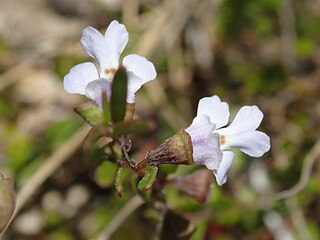
Prostanthera junonis, commonly known as Somersby mintbush, is a species of flowering plant in the family Lamiaceae and is endemic to the Central Coast of New South Wales. It is a low, straggling shrub with hairy, egg-shaped leaves and purple to mauve flowers.
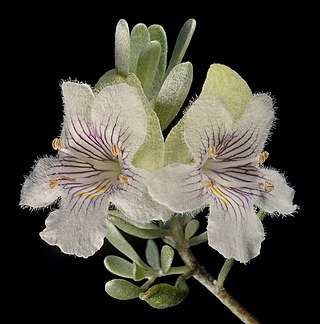
Prostanthera althoferi is a species of flowering plant in the family Lamiaceae and is endemic to inland areas of Australia. It is an erect shrub with its stems and leaves densely covered with silvery, greyish-green hairs, and has narrow egg-shaped leaves and white to cream-coloured flowers with mauve or purple striations inside.
Prostanthera athertoniana is a species of flowering plant in the family Lamiaceae and is endemic to a restricted area of Queensland. It is a small, densely-foliaged shrub with strongly aromatic, elliptical, oblong or egg-shaped leaves and hairy, purplish-mauve flowers arranged singly in upper leaf axils.

Prostanthera canaliculata is a species of flowering plant in the family Lamiaceae and is endemic to the south-west of Western Australia. It is a small, erect shrub with hairy branchlets, narrow egg-shaped to narrow elliptical leaves and pale blue or pale violet to white flowers with no markings.
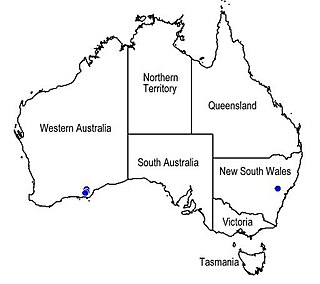
Prostanthera carrickiana, commonly known as Carrick's mintbush, is a species of flowering plant in the family Lamiaceae and is endemic to a restricted area in the south-west of Western Australia. It is an erect shrub with hairy branchlets, elliptical leaves pinkish-red flowers.

Prostanthera clotteniana is a species of flowering plant in the family Lamiaceae and is endemic to tropical north Queensland. It is a shrub with cylindrical, hairy branches, narrow egg-shaped leaves with the narrower end towards the base, and purple to pale lilac flowers.
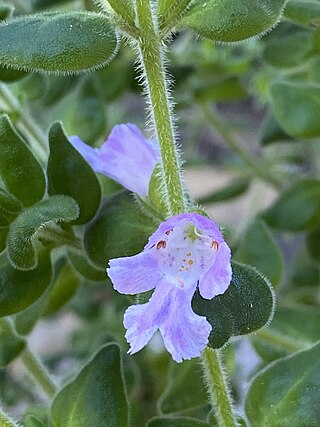
Prostanthera densa, commonly known as villous mint-bush, is a species of flowering plant in the family Lamiaceae and is endemic to near-coastal areas of New South Wales. It is an erect, often compact shrub with aromatic branches, egg-shaped leaves, and mauve flowers with orange markings inside.

Prostanthera eungella is a species of flowering plant in the family Lamiaceae and is endemic to the Eungella region in Queensland. It is an erect shrub with narrow egg-shaped leaves with small teeth, and mauve flowers that are white inside the petal tube and arranged in upper leaf axils.
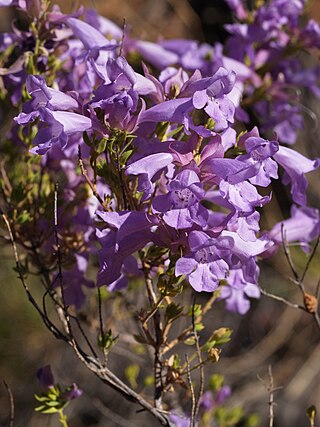
Prostanthera ferricola is a species of flowering plant in the family Lamiaceae and is endemic to central Western Australia. It is an erect, openly branched shrub with aromatic, egg-shaped leaves and mauve-purple flowers arranged in four to twelve leaf axils near the end of branchlets.
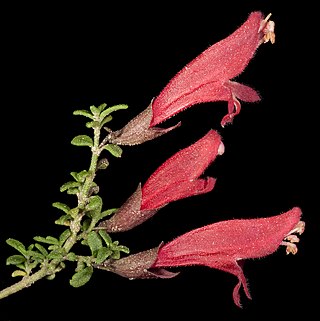
Prostanthera grylloana is a species of flowering plant in the family Lamiaceae and is endemic to Western Australia. It is a small, erect shrub with densely hairy branchlets, small, spatula-shaped leaves and red to pink flowers.

Prostanthera hindii is a species of flowering plant in the family Lamiaceae and is endemic to the Central Tablelands of New South Wales. It is a small, erect shrub with densely hairy branches, egg-shaped leaves, and mauve flowers with deep mauve to dark purple colouration inside the petal tube.

Prostanthera incurvata is a species of flowering plant in the family Lamiaceae and is endemic to the inland of Western Australia. It is a small, erect shrub with hairy branches, narrow oblong to narrow egg-shaped leaves with the narrower end towards the base, and pink to red, sometimes yellow flowers.

Prostanthera laricoides is a species of flowering plant in the family Lamiaceae and is endemic to the inland of Western Australia. It is a small shrub with densely hairy, densely glandular branchlets, cylindrical leaves clustered near the ends of branchlets, and dull, light red flowers.
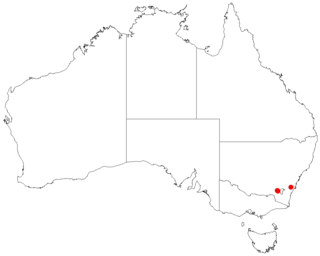
Prostanthera makinsonii is a species of flowering plant in the family Lamiaceae and is endemic to a restricted area of New South Wales. It is a spreading shrub with strongly aromatic, egg-shaped leaves and mostly glabrous purple flowers arranged in bunches of eight to twelve in upper leaf axils.
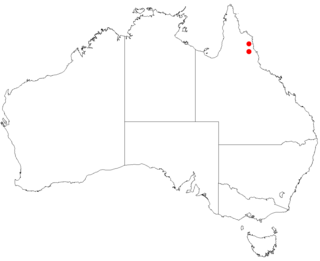
Prostanthera mulliganensis, commonly known as Mount Mulligan prostanthera, is a species of flowering plant that is endemic to Mount Mulligan in Queensland. It is a small shrub with hairy branchlets, oblong to egg-shaped leaves and mauve flowers with purple to dark mauve markings.

Prostanthera oleoides is a species of flowering plant that is endemic to central Queensland. It is an open, erect shrub with four-sided branchlets, narrow elliptic, oblong or egg-shaped leaves with the narrower end towards the base, and mauve flowers with purple to dark mauve markings.

Prostanthera tozerana is a species of flowering plant that is endemic to Mount Tozer in Queensland. It is a small, compact shrub with hairy branchlets, thick egg-shaped leaves with the narrower end towards the base, and pale purplish-mauve flowers.




















